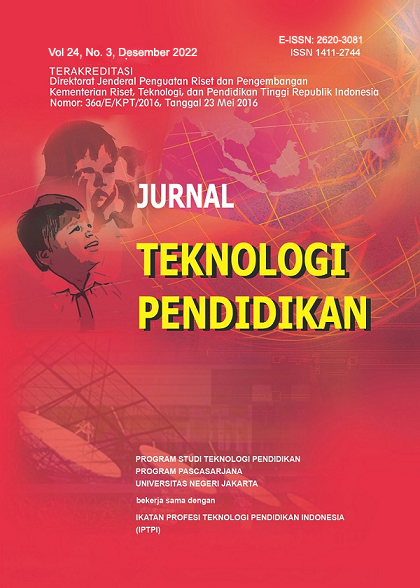Development of Storyboard Media to Improve Storytelling Skills on The Material Plant Breeding in Elementary School
DOI:
https://doi.org/10.21009/jtp.v24i3.31668Keywords:
storyboard, storytelling skills, plant breedingAbstract
The world of education today is developing so fast. Students are required to be able to master skills, one of which is storytelling skills. Students' low skills in storytelling are one of the consequences of implementing online learning so far. The purpose of this study is to regenerate and improve storytelling skills in grade VI students at SDN 21 Muara Telang, especially in Plant Breeding material. This research is a research and development (R&D) research that produces products in the form of learning media in the form of storyboards that are tested for effectiveness to increase students' ability to tell stories. The model used in this study is the ADDIE maodel, where the stages include: analysis, design, development, implementation and evaluation. The result of this study is the production of a product in the form of storyboard media that is proven to improve storytelling skills in grade VI students at SDN 21 Muara Telang, Banyuasin regency.
References
Andi, R., & Rismayanti. (2021). Application of the ADDIE Model in Learning Media Development at SMPN 22 Samarinda City. Journal of Fasilkom Volume 11 No.2, 57-60. https://doi.org/10.37859/jf.v11i2.2546
Andreas, D. (2013). Easy Ways to Design Storyboards For Cool Animations. Yogyakarta: Taka Publisher.
Anggraeni, D. R., Elmunsyah, H., & handayani, A. N. (2019). Development of Fuzzy Learning Modules in the Intelligent Systems Course for S1 Electrical Engineering Education Students, State University of Malang. Journal of Technology, Electrical and Vocational, 26-40. https://doi.org/10.17977/um034v29i1p26-40
Aries, S. (2017). Improving Storytelling Skills By Using Teaching Aids for Students who Practice in the Laboratory of the Indonesian Language and Literature Education Study Program for the 2016/2017 Academic Year. Scientific Journal of Pend.Language, Indonesian and Regional Literature Vol 7. No.2, 153-159. https://doi.org/10.23969/literasi.v7i2.535
Asha, L. (2019). Managerial Steps of School Principals in Improving the Competence of Islamic Teachers in Madrasah Aliyah Muhammadiyah Curup. FOCUS Journal of Islamic and Social Studies. https://doi.org/10.29240/jf.v4i2.1120
Branch, R. M. (2009). Instructional Design : The ADDIE Approach. Georgia: Springer New York Dordrecht Heidelberg London. https://doi.org/10.1007/978-0-387-09506-6
Cahyadi, R. A. (2019). Development of ADDIE Model-Based Teaching Materials. Educational Journal, 35-53. https://doi.org/10.21070/halaqa.v3i1.2124
Fitri, H., & Muhammad, N. (2021). ADDIE Model in Islamic Religious Education Learning. Journal of Islamic Religious Education Innovation, Vol 1 No.1, 28-37. https://doi.org/10.15575/jipai.v1i1.11042
Idolla, A., & Al-Hafizh, M. (2013). Using Multimedia Storyboard In Teaching Writing a Descriptive Text. Journal Of English Language Teaching, 121-126.
Ministry of Education and Culture. (2020). Ministry of Education and Culture.
Kunto, I., Diana, A., Retno, W., & Syahyani, R. (2021). Variety of Storyboards for Learning Media Production. Journal of Innovative Learning, 108-119. https://doi.org/10.21009/JPI.041.14
Lestari, H., Agustini, K., & Sugihartini, N. (2019). Development of Project-based Learning-Based Storyboard Teaching Module for Class XI Multimedia Students at SMK TI Bali Global Singaraja. Collection of Informatics Engineering Education Student Articles (KARMAPATI), 309-318. https://doi.org/10.23887/karmapati.v8i2.18379
Mulyati, Y. (2014). The Nature of Language Skills. Jakarta: Open University.
Musfiroh, T. (2005). Storytelling For Early Childhood. Jakarta: Ministry of Education and Culture.
Nau, M. C., Ngura, E. T., & Meo, K. R. (2022). Development of Storyboards to Improve Early Childhood Speaking Skills Class B in PAUD Terpadu Citra Bakti Ngada. Journal of Children's Education, 135-144.
Nyoman Sugihartini, K. Y. (2018). ADDIE As a Model for The Development of Educational Instructional Media (MIE) Curriculum and Teaching Courses. Journal of Technological and Vocational Education, 227. https://doi.org/10.23887/jptk-undiksha.v15i2.14892
Rahmah. (2016). Improving the Storytelling Ability of Grade II Students through the Use of Image Media about Daily Activities at SDN Jatinegara 06 Pagi East Jakarta. Jakarta: repository.unj.ac.id/1521/8/JURNAL%20SKRIPSI%20RAHMAH.pdf.
Rani, W., & Astuti, E. R. (2019). The Effect of Using Storyboard Learning Media on Student Learning Creativity in Cultural Arts Subjects. Journal of Educational Technology, 69-78.
Rohayati, E. (2018). Character Storytelling Skills Development Methods for Early Childhood Education. Early horizons : Journal of Early Childhood Education. https://doi.org/10.17509/cd.v3i1.10320
Sugiyono. (2011). Educational Research Methods. London: Alfabeta.
Tarigan, H. G. (2013). Language Education Research Methods. London: Rosdakarya.
Wa Ode, R., & Nurul Sri, D. (2022). Improving Storytelling Skills by Using Image Media for Grade IV Elementary School Students. Taxonomy Journal of Primary Education, 57-63.
Youllia, I., & Senyelda, D. (2011). Implementation of the Cmifed Model on Interactive Multimedia for Kindergarten and Playgroup Age Learning. Journal of Informatics, No 2 Vol.2, 1-12.
Downloads
Published
How to Cite
Issue
Section
License
Jurnal Teknologi Pendidikan is an Open Access Journal. The authors who publish the manuscript in Jurnal Teknologi Pendidikan agree to the following terms.
Attribution-ShareAlike 4.0 International (CC BY-SA 4.0)
-
Attribution — You must give appropriate credit, provide a link to the license, and indicate if changes were made. You may do so in any reasonable manner, but not in any way that suggests the licensor endorses you or your use.
-
ShareAlike — If you remix, transform, or build upon the material, you must distribute your contributions under the same license as the original.
- No additional restrictions — You may not apply legal terms or technological measures that legally restrict others from doing anything the license permits.
Notices:
- You do not have to comply with the license for elements of the material in the public domain or where your use is permitted by an applicable exception or limitation.
- No warranties are given. The license may not give you all of the permissions necessary for your intended use. For example, other rights such as publicity, privacy, or moral rights may limit how you use the material.








